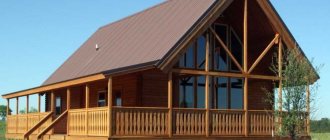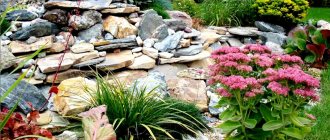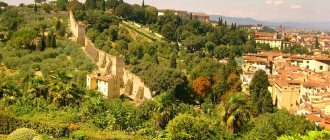Home » Landscape design
Fedurina Nadezhda 03/23/2020
1782 Views
A rock garden (from the English rock - rock, stone) created with your own hands is a great opportunity to realize your bold fantasies of creating a stone garden. The original composition will become the highlight of the garden plot and emphasize the individuality of its owner.
How to prepare a place for an alpine slide?
Start preparatory work in the fall. Apply markings to the selected area, then remove a layer of soil 25-30 cm thick from it, pour drainage (gravel, expanded clay, broken brick) into the resulting hole, then a layer of sand and fertile soil (a mixture of humus, sand and nutritious soil that meets the requirements of plants , which you are going to plant).
Most plants will benefit from a loose substrate with a small amount of organic matter. However, heathers (heather, Erica, rhododendron) do not like alkaline soils, so in the places where you plan to plant them, add peat to the soil.
Preliminary preparation
A rock garden can be either in the form of a garden and park complex with paths, water features and architectural forms, or a small corner of your summer cottage, which you can arrange yourself
First you should choose the rockery style, size and location.
Interesting ideas
The design of the rock garden is matched to the style of the site and fits into the terrain
In the landscape composition, the buildings and structures available on the plot are used; these can be architectural forms or a retaining wall . Before creating a garden, it will be useful to look at examples of photos and diagrams of rockeries.
Composition with wooden elements
Stone garden with coniferous plants
Rocky mix-border along the sidewalk path
Composition “dry stream”
Choosing a place
Flower garden near the pond
It is desirable that the composition be visible from all sides. A stone garden against the background of a fence is not the best idea, but if there is no other place, then climbing plants will help decorate the background. Suitable places for rock gardens: entrance area, recreation areas near ponds, garden, backyard.
To avoid having to clear the garden of fallen leaves every autumn, you should not build a flower garden under deciduous trees. It is also undesirable to place a stone garden close to the house - snow falling abundantly from the roof can ruin the appearance of the composition.
You can make a rock garden both on a flat terrain and on a hill with natural elevation changes.
Drawing a plan
Composition scheme
Before building a rock garden, a diagram of the future garden is created on paper or in a graphic program - it is important to think about where each stone will be located, which of them will become the main element of the composition. Then you should place the plants schematically, leaving free space, taking into account further growth.
If the rockery will be visible from all sides, tall elements should be correctly placed in the center. When viewed from only one side, large objects are placed in the background.
The garden layout consists of several large stones, ornamental plants planted between them and a gravel backfill. The external outlines of the composition are created close to the natural pattern of the area. To prevent the rockery from looking artificial, it is not made rectangular or square; smooth curved borders look better.
About choosing stones
Suitable stones for the garden
It must be taken into account that stones are the basis of a rock garden; the perception of the composition depends on their selection, location on the site and combination with each other. The main criteria for selection are durability, decorativeness, and naturalness. All materials can be used, except for rocks containing a lot of chalk.
It is recommended to introduce bright and dark materials with caution, preferably rocks with natural tones. The stones should be poorly processed and rough; old blocks covered with moss or lichen look good. Large sharp stones should be avoided; they cause visual and psychological dissonance.
Stones are chosen of the same or similar material in structure, but of different sizes. Large ones will form the basis of the composition, and small ones will add naturalness. Rocks used: sandstone, tuff, limestone, slate, basalt, shell rock. The surface is covered with crushed stone, gravel, and pebbles.
What plants to choose for rock gardens and rock gardens?
When choosing plants, first of all pay attention to dwarf coniferous trees and shrubs. They can be placed on all tiers of the hill, and tall conifers can be placed against the background of this flower bed.
In addition, heather, Erica, rhododendron, poppy, alpine edelweiss, Carpathian bellflower, sunflower, rezuha, rock alyssum, saxifrage, soapwort, fescue, Iberis, gentian, aubrieta, semolina, primrose are ideal for rocky gardens and alpine hills.
If there is little sun on your site, choose shade-loving and moisture-resistant plants.
- Alpine slide for a beginner - choose the most unpretentious plants
Do you want to organize an alpine slide on your site, but don’t know where to start? We will help you choose the right plants.
Basic rules and nuances of creation
Composition with conifers
When arranging a rocky garden, it is important to follow the basic principles:
- A place for a rock garden is selected without unnecessary elements that could disrupt the integrity of the composition - large trees, flower beds, fences
- Stones are preferred that are close in origin and style, imitating the landscape of a certain area. The central element of the composition can be a large stone or plant
- We install stones, avoiding excessive symmetry in arrangement - nature is chaotic
- As plants grow, they should not completely cover the stones; slow-growing species are used for rockeries
- It is important to remember about the drainage layer - too wet soil is destructive for the roots of many species
Sometimes novice designers mistakenly assume that the more stones and plants, the better. This is not so - the beauty of a stone garden lies in its brevity and harmonious arrangement of all elements.
How to care for an alpine slide and rock garden?
Caring for plants in a rock garden is the same as in other flower beds. They need to be watered (but it is important not to overwater them!), treated against diseases and pests, weeded, and faded buds trimmed.
But keep in mind: many “alpine” plants respond poorly to feeding, especially organic matter. You only need to apply minimal doses of mineral fertilizers. Dig up heat-loving bulbous plants for the winter, mulch the rest and cover with spruce branches or spunbond.
Don't forget about the stones. Periodically clean them of dirt and promptly replace cracked parts with new ones.
- How to properly care for an alpine slide - 7 “golden” rules
Several rules for caring for an alpine slide, tested empirically.
Selecting plants
Plants in rock gardens
Dwarf varieties of conifers, decorative deciduous and flowering shrubs, perennial herbs and flowers, and ground cover are suitable for planting in stone flower beds. Less commonly used for decoration are bulbous plants (tulips, hyacinths, daffodils).
Coniferous species
Composition with juniper
Coniferous species When selecting plants for a rock garden, coniferous species are popular: miniature varieties of cypresses, pines, spruces, hemlocks, junipers, fir trees.
Varieties commonly used for planting include:
- mountain pine (Pinus mugo) – Mops, Gnom and Winter Gold
- horizontal juniper (Juniperus horizontalis) - Wiltonii and Blue Moon
- leaning juniper (Juniperus procumbens) – Nana
- juniper (Juniperus squamata) – Blue Carpet, Blue Star
- Thuja occidentalis - Danica, Teddy, Ellwangeriana Aurea
- Canadian hemlock (Tsuga canadensis) - Bennett, Gracilis Oldenburg, Minima
- cypress (Chamaecyparis)
- Norway spruce (Picea abies) - Nidiformis
- Korean fir (Abies koreana) – Brillant, Alpin Star
Choose species with richly colored needles and an interesting shape.
Deciduous plants
Barberry in landscape design
Deciduous plants Present in the form of shrubs and dwarf trees.
Often used:
- cotoneaster horizontalis
- honeysuckle (Lonicera pileata)
- Japanese spirea (Spiraea japonica)
- Thunberg's barberry (Berberis thunbergii)
- creeping willow (Salix repens)
Perennial herbs and flowers, cereals and ground cover species
Plants for a stone garden
Perennial herbs and flowers, cereals and ground cover species. Perennial herbs and flowers will decorate the rockery - primrose, geranium, petunia, crocuses, yarrow, hosta, irises, delphinium, lavender, daylily, lumbago, immortelle, St. John's wort, gypsophila, etc.
Cereals include fescue, barley, feather grass, bluegrass, and millet.
Mandatory plants in rock gardens that create a fluffy layer are plantings of ground cover perennials. These include: sedum, subulate phlox, aubriettes, arabis, saxifrage, etc.
Important points to consider:
- choose slow-growing, unpretentious species
- plant height for medium-sized areas no more than 1 m , for small ones up to 0.5 m
- To maintain year-round decorativeness, the frequency of flowering is taken into account . Some flowers are planted in separate flowerpots or flowerpots
- in classic versions, only perennial plants are used
- For a shaded garden, moisture-loving species are suitable: wood sorrel, oxalis, primula, buttercups and ferns. For sunny days - wormwood, edelweiss, armeria, thyme
- take into account the needs of plants for light , moisture, soil composition
- Before planting plants, they think through the color scheme , combination of shapes and textures
How to decorate a rock garden and rock garden?
An excellent solution would be to decorate a rocky garden with a small pond. The pond should look natural, so make the banks uneven, put driftwood on the bottom, and plant marsh plants.
Using a water pump, you can let a stream flow over the rocks. It will make the rocky garden even more attractive. And if you don't want to bother with water, make a dry stream from pebbles.
Show your imagination and you can arrange an unusual rocky garden or rock garden at your dacha. And if you don’t have any thoughts on this matter, our article 15 original ideas on how to equip an alpine hill in your country house will help you.
Benefits of rock garden
Rockery in landscape design
The main advantage compared to a rock garden is the use of not only alpine species that grow poorly in the middle zone. For rockeries, the variety of plants is much higher, they are less demanding on the soil, often have a powerful root system, and are easier to care for. There is also no labor-intensive construction of a slide; a flat rock garden is not subject to soil washing out and stones sliding.
Unlike flower beds, rockeries look impressive, natural and perfectly decorate problem areas of the dacha - barren areas and blind areas of buildings. A rocky flower garden will not only decorate the garden, but also help protect the soil from erosion.
Selecting a location
If you are interested in how to make a rock garden with your own hands, you will get the answer right now. Creating a stone garden is not particularly difficult. You just need to know a few nuances that will help you create a delightful composition.
The rockery should be in harmony with the overall design of the garden
And we will start by choosing a place for the future rock garden. It is noteworthy that it can be placed almost anywhere. Ideally, on a flat area with nearby hills and ravines. They will help you realize your original design idea.
- Since most of our common plants are light-loving, choose a sunny place. A slight shadow is also allowed.
- Make sure that water does not accumulate in this place, especially if the winter was snowy. The roots will begin to rot quickly.
- Tall trees are also not welcome. They will not be able to fit into the overall picture of the stone structure.
- It is not recommended to place a rockery made of conifers close to the house or other buildings. It is near them that snow most often accumulates. During the melting process, it will simply destroy the rock garden.
Simple rock garden
Do not start construction until you have fenced the area. For example, using a rope or tape. Think about how you would like to arrange the stones and plant the plants on a regular piece of paper. Then prepare your tools:
- A shovel.
- A net or film that will protect your plants from pests (moles) and weeds.
- Scoop – makes it easier to plant greens.
- Grooming rake.
- Watering can.
- A sprayer and pruning shears will also not be superfluous.
The materials you will need are sand, gravel or stones, and cement. Naturally, suitable plants, peat and soil.
Rockery along the path
Types of rockeries
There are several classifications of rockeries, which we will introduce you to:
- Slide. It has a certain resemblance to a rock garden: numerous plants, sheer ledges and sharp cliffs.
- Flat version. It is located on a perfectly flat area and occupies a fairly large area. In the summer, plants suffer much less from the heat, and they are practically not afraid of frost.
- Wall. Basically, such rockeries are used for zoning the yard. Made in the form of a support or stone wall.
Type of rockery: wall
Also, a do-it-yourself rockery in the country may differ in location. For sunny areas, heat-loving plants are selected - for example, gentianas or bells. If you are planning to make a flower garden in a shaded area, it is recommended to plant shade-preferring plants there. For example, astilbe or heuchera.
Selection of stones and their placement
Any step-by-step instruction states that the main accent of the rock garden was and remains stones. In most cases, they are matched to the color of the building or landscape. The main criteria: natural appearance, the ability to pass not only air, but also water. Most often, landscape designers use stones such as tuff, granite, limestone and sandstone.
Stone selection
The use of natural stone, rich in shapes and shades, opens up truly limitless space for imagination. At the same time, there are several nuances that should be taken into account when arranging stones:
- In a dry rock garden, angular stones are quite acceptable. If you plan to arrange a stone garden along with a small pond, you should give preference to round boulders.
- The size and shape of the stones should be different. They are selected based on the total area of the rockery. For example, if the area is large, small pebbles will look awkward. And vice versa.
- Use one, maximum two types of stones. Make sure they match the color of the landscape.
We can conclude that laying a rock garden with your own hands, a photo of which you will find in this section, is a creative, incredibly exciting process.
It is better to choose stones of the same type











